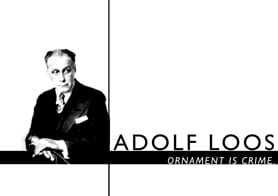Ornament and Crime?
Got your attention? Well I’m not really going to write about that. However, that was the title of a famous essay written by the architect, Adolf Loos, in 1908. He was a founding member of the “Bauhaus,” a modern movement that approached design with a heightened sense of the beauty and efficiency of things designed quite simply and thoughtfully for use.
Proclaiming, “No ornament can any longer be made today by anyone who lives on our cultural level … Freedom from ornament is a sign of spiritual strength,” Loos wielded the sword against ornamentation in design. It is almost funny how he cites the preponderance of tattooed people in prison as proof that he is right. Well, he would be floored by the renaissance of body ornamentation in our age. Perhaps he would say it is a sign of loss of spiritual strength….and maybe he would be right.
But I am going to explore Ornamentation and Massage.
Just like a building needs clear lines of structural support, we need a “superstructure” of techniques that home in on problems as manifest by the myofascial, and ultimately, nervous systems. However, regardless of the modality, our bold strokes, to be truly effective, periodically call for added ornamentation. After, for instance, a deep stroke down a hamstring, it may leave the client with a more integrated feeling to add a little rocking or a single petrissage or a nerve stroke. These ornamentations add a fresh, unpredictable element to the flow of our sessions. They are very much part of the art because when it comes to being unpredictable, the massage therapists/artist must be creative and judicious – deciding just which additional strokes or therapeutic “gestures’ to add to provide a deeper, more integrated experience for the receiver.
These ornamentations in touch are of necessity improvised – as were for instance the ornamentations added by individual instrumentalists in Bach’s day. Trills, “turns,” and “grace notes” added to clear melodies go by so fast that the listener’s left brain can’t follow them. So it gives up, affording the listener the opportunity to experience the music more with their whole self.
Equally and often as integrating are well-timed pauses in massage in which one can imagine clients themselves are being given the gift of silence and open time during which they may explore their inner world without further input. It’s almost like giving the receiver time for inner ornamentation, reflection, and re-arrangement.
So this tapestry of bold strokes, pauses, and timely ornamentations are what facilitate the possibility that we can help create what Blake, that great artist of words and pictures, meant when he spoke of holding “Infinity in the palm of your hand And Eternity in an hour.”
When therapists first start doing massage, they are often challenged to fit everything into an hour. As more seasoned therapists, more deeply familiar with both the science and the art, it is a fascinating challenge to continue to at least touch everything briefly, while combining, in a seamless therapeutic design – our bold strokes, well-timed pauses, and beautiful touch ornamentations – that result, like all great art, in the recipient ‘s opportunity to see and make their world anew.
https://www.youtube.com/watch?v=A2MfdZCais0 – This is link to a video in which you can hear how much meaning the ornamentation – trills, turns and ‘grace’ notes – add in Bach’s music.

